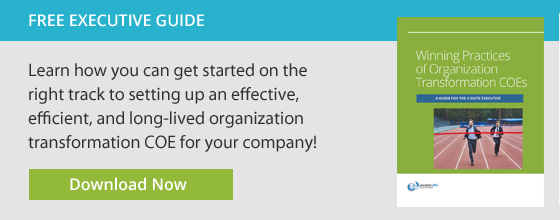To stay competitive, organizations today must be agile and adapt quickly to rapidly changing markets, technology, and economic conditions. Effective change management is therefore essential. Change management initiatives can be handled in various ways within an organization. Outsourcing is certainly an option, but another tactic that many organizations have used with varying degrees of success is to set up an internal center of expertise (COE) to facilitate organization change efforts.
Because every organization is different, there is no one best way to set up a change transformation COE. However, while each should be set up with the unique culture, challenges, and goals of that organization in mind, there are five basic best practices that will help to optimize your COEs chances of success.
Building a Successful Organization Change COE: 5 Steps to Success
Because each of these winning practices builds on the next, we recommend addressing the following steps in sequence:
1. Clarify the “Why” Behind Your COE
What specific business problem is your organization facing that your COE is being created to help solve? If you are not clear on this, your COE is unlikely to come up with solutions that are in alignment with your organization’s strategy.
Once you’ve defined the challenge you’re addressing, this step also entails clearly defining exactly which solutions you will offer (e.g.) coaching or consulting, providing tools and/or data, or offering hands-on help such as project management. And, you’ll want to be sure there is a clear business case for creating the COE in the first place.
2. Define Your COE’s Engagement Model
An organization change COE that encroaches on the roles of others in the organization or fails to work harmoniously with the individuals, teams, and functions it is intended to help may end up doing more harm than good. Put some thought into defining your COE’s roles, as well as how you will balance resourcing and service levels. Consider also how you might leverage external partners to help fill in gaps of expertise or take up slack during busy periods.
3. Choose Appropriate Tools and Methodologies
Methodologies and toolsets can be developed in house or purchased. Or, you can adapt existing ones to suit your unique needs. In this step, you’ll want to keep your decisions from the previous steps in mind as you select the tools and methodologies that will help your COE best meet the goals and needs of your organization.
4. Capability Building and Long Term Planning
Good talent is essential to building a successful organization transformation COE. Since change management skills are in high demand and short supply, it is critical to think through how you will find and retain talent. Will you train internally or outsource? What is your training plan? The life span of an average change transformation COE is only three years; do you have a sustainment plan in place to help your COE survive and continue to deliver value for at least that long or longer? Do you know how you will help business partners and organization leaders become aware of your COE and how to use it effectively?
5. Measure Impact
Once your COE is functioning, the last step is to track the metrics so that you can determine how well it is delivering on its promises and whether the business case is still there for it to exist. Here, you will need to decide what metrics to use and how you will factor in the impact of other variables on these metrics. It’s also a good idea to get clear in advance on how much time and energy you want to spend on collecting and analyzing data.
Ready to Move Forward With Your Organization Transformation COE?
Being aware of these five best practices will give you a significant advantage as you start to build your organization change COE. If you would like to explore this topic in greater depth, please access the full study on how to implement Winning Practices of Organization Transformation COEs.






